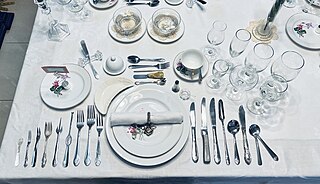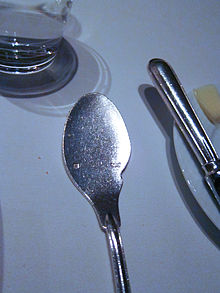
A spoon is a utensil consisting of a shallow bowl, oval or round, at the end of a handle. A type of cutlery, especially as part of a place setting, it is used primarily for transferring food to the mouth. Spoons are also used in food preparation to measure, mix, stir and toss ingredients and for serving food. Present day spoons are made from metal, wood, porcelain or plastic. There are a wide variety of spoons that are made of a variety of materials and by different cultures for many different uses and foods.

A beefsteak, often called just steak, is a flat cut of beef with parallel faces, usually cut perpendicular to the muscle fibers. In common restaurant service a single serving has a raw mass ranging from 120 to 600 grams. Beef steaks are usually grilled, pan-fried, or broiled. The more tender cuts from the loin and rib are cooked quickly, using dry heat, and served whole. Less tender cuts from the chuck or round are cooked with moist heat or are mechanically tenderized.

Donburi is a Japanese "rice-bowl dish" consisting of fish, meat, vegetables or other ingredients simmered together and served over rice. Donburi meals are usually served in oversized rice bowls which are also called donburi. If one needs to distinguish, the bowl is called donburi-bachi and the food is called donburi-mono.

Phở or pho is a Vietnamese soup dish consisting of broth, rice noodles, herbs, and meat. Phở is a popular food in Vietnam where it is served in households, street stalls and restaurants countrywide. Nam Định people were the first to create Vietnamese traditional phở. Phở is considered Vietnam's national dish.

Churrasco is the Portuguese and Spanish name for beef or grilled meat more generally. It is a prominent feature in the cuisine of Brazil, Uruguay, and Argentina. The related term churrascaria is mostly understood to be a steakhouse restaurant serving grilled meat, many offering as much as one can eat: servers move around the restaurant with skewers, slicing meat onto the customer's plate. This serving style is called espeto corrido or rodízio, and is quite popular in Brazil, especially in southern states like Rio Grande do Sul, Paraná, Santa Catarina, and São Paulo.

A schnitzel is a thin slice of meat. The meat is usually thinned by pounding with a meat tenderizer. Most commonly, the meat is breaded before frying. Breaded schnitzel is popular in many countries and is made using veal, pork, chicken, mutton, beef, or turkey. Schnitzel is very similar to the dish escalope in France and Spain, tonkatsu in Japan, cotoletta in Italy, kotlet schabowy in Poland, milanesa in Argentina, chuleta valluna in Colombia, and chicken-fried steak and pork tenderloin of the United States.

Tableware is any dish or dishware used for setting a table, serving food, and dining. It includes cutlery, glassware, serving dishes, and other items for practical as well as decorative purposes. The quality, nature, variety and number of objects varies according to culture, religion, number of diners, cuisine and occasion. For example, Middle Eastern, Indian or Polynesian food culture and cuisine sometimes limits tableware to serving dishes, using bread or leaves as individual plates. Special occasions are usually reflected in higher quality tableware.

Popiah is a Fujianese/Teochew-style fresh spring roll filled with an assortment of fresh, dried, and cooked ingredients, eaten during the Qingming Festival and other celebratory occasions. The dish is made by the people and diaspora of Fujian province of Mainland China, neighbouring Chaoshan district, and by the Teochew and Hoklo diaspora in various regions throughout Southeast Asia and in Taiwan, The origin of popiah dates back to the 17th century.

A full-course dinner is a dinner consisting of multiple dishes, or courses. In its simplest form, it can consist of three or four courses; for example: first course, a main course, and dessert.

Malaysian Chinese cuisine is derived from the culinary traditions of Chinese Malaysian immigrants and their descendants, who have adapted or modified their culinary traditions under the influence of Malaysian culture as well as immigration patterns of Chinese to Malaysia. Because the vast majority of Chinese Malaysians are descendants of immigrants from southern China, Malaysian Chinese cuisine is predominantly based on an eclectic repertoire of dishes with roots from Fujian, Cantonese, Hakka and Teochew cuisines.

Noodle soup refers to a variety of soups with noodles and other ingredients served in a light broth. Noodle soup is a common dish across East Asia, Southeast Asia and the Himalayan states of South Asia. Various types of noodles are used, such as rice noodles, wheat noodles and egg noodles.

A floating island or île flottante is a dessert consisting of meringue floating on crème anglaise. The meringue is prepared from whipped egg whites, sugar, and vanilla extract and baked in a bain-marie. The crème anglaise is prepared with the egg yolks, vanilla, and hot milk, briefly cooked.

Table manners are the rules of etiquette used while eating, which may also include the use of utensils. Different cultures observe different rules for table manners. Each family or group sets its own standards for how strictly these rules are to be followed.

Padang food or Minang food is the cuisine of the Minangkabau people of West Sumatra, Indonesia. It is among the most popular cuisines in Maritime Southeast Asia. It is known across Indonesia as Masakan Padang after Padang, the capital city of Western Sumatra province. It is served in restaurants mostly owned by perantauan (migrating) Minangkabau people in Indonesian cities. Padang food is ubiquitous in Indonesian cities and is popular in neighboring Malaysia and Singapore.

Crossing-the-bridge noodles is a rice noodle soup originating from the Yunnan province of China. It is one of the best-known dishes in Yunnan cuisine.

In Japanese cuisine, yōshoku refers to a style of Western-influenced cooking which originated during the Meiji Restoration. These are primarily Japanized forms of European dishes, often featuring Western names, and usually written in katakana. It is an example of fusion cuisine.

Spring rolls are rolled appetizers or dim sum commonly found in Chinese and other Southeast Asian cuisines. The kind of wrapper, fillings, and cooking technique used, as well as the name, vary considerably within this large area, depending on the region's culture.

Jiaozi are Chinese dumplings commonly eaten in China and other parts of East Asia. Jiaozi are folded to resemble Chinese sycee and have great cultural significance attached to them within China. Jiaozi are one of the major dishes eaten during the Chinese New Year throughout Northern China and eaten all year round in the northern provinces. Though considered part of Chinese cuisine, jiaozi are popular in other parts of East Asia and in the Western world, where a fried variety is sometimes called potstickers in North America and Chinese dumplings in the UK and Canada. The English-language term "potsticker" is a calque of the Mandarin word "guotie" (鍋貼). Potsticker was used by Buwei Yang Chao and her husband Yuen Ren Chao in the book How to Cook and Eat in Chinese, which was first published in 1945. In northern China, however, "guotie" specifically refers to a type of pan-fried jiaozi with its ends left open rather than just any pan-fried jiaozi.

Japanese dining etiquette is a set of traditional perceptions governing specific expectations which outlines general standards of how one should behave and respond in various dining situations.



















